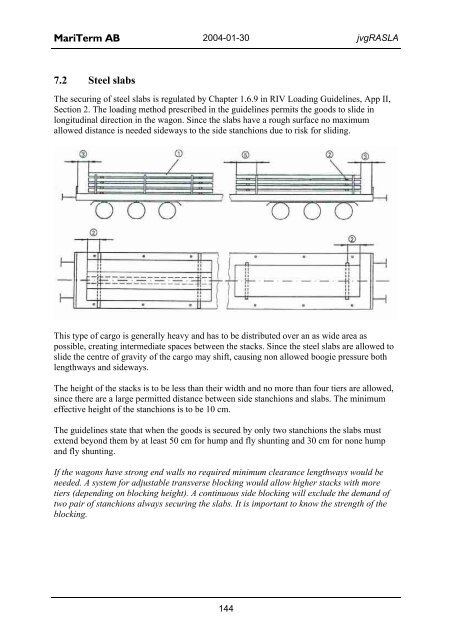Equipment for Rational Securing of Cargo on Railway ... - Vinnova
Equipment for Rational Securing of Cargo on Railway ... - Vinnova
Equipment for Rational Securing of Cargo on Railway ... - Vinnova
You also want an ePaper? Increase the reach of your titles
YUMPU automatically turns print PDFs into web optimized ePapers that Google loves.
MariTerm AB 2004-01-30 jvgRASLA<br />
7.2 Steel slabs<br />
The securing <str<strong>on</strong>g>of</str<strong>on</strong>g> steel slabs is regulated by Chapter 1.6.9 in RIV Loading Guidelines, App II,<br />
Secti<strong>on</strong> 2. The loading method prescribed in the guidelines permits the goods to slide in<br />
l<strong>on</strong>gitudinal directi<strong>on</strong> in the wag<strong>on</strong>. Since the slabs have a rough surface no maximum<br />
allowed distance is needed sideways to the side stanchi<strong>on</strong>s due to risk <str<strong>on</strong>g>for</str<strong>on</strong>g> sliding.<br />
This type <str<strong>on</strong>g>of</str<strong>on</strong>g> cargo is generally heavy and has to be distributed over an as wide area as<br />
possible, creating intermediate spaces between the stacks. Since the steel slabs are allowed to<br />
slide the centre <str<strong>on</strong>g>of</str<strong>on</strong>g> gravity <str<strong>on</strong>g>of</str<strong>on</strong>g> the cargo may shift, causing n<strong>on</strong> allowed boogie pressure both<br />
lengthways and sideways.<br />
The height <str<strong>on</strong>g>of</str<strong>on</strong>g> the stacks is to be less than their width and no more than four tiers are allowed,<br />
since there are a large permitted distance between side stanchi<strong>on</strong>s and slabs. The minimum<br />
effective height <str<strong>on</strong>g>of</str<strong>on</strong>g> the stanchi<strong>on</strong>s is to be 10 cm.<br />
The guidelines state that when the goods is secured by <strong>on</strong>ly two stanchi<strong>on</strong>s the slabs must<br />
extend bey<strong>on</strong>d them by at least 50 cm <str<strong>on</strong>g>for</str<strong>on</strong>g> hump and fly shunting and 30 cm <str<strong>on</strong>g>for</str<strong>on</strong>g> n<strong>on</strong>e hump<br />
and fly shunting.<br />
If the wag<strong>on</strong>s have str<strong>on</strong>g end walls no required minimum clearance lengthways would be<br />
needed. A system <str<strong>on</strong>g>for</str<strong>on</strong>g> adjustable transverse blocking would allow higher stacks with more<br />
tiers (depending <strong>on</strong> blocking height). A c<strong>on</strong>tinuous side blocking will exclude the demand <str<strong>on</strong>g>of</str<strong>on</strong>g><br />
two pair <str<strong>on</strong>g>of</str<strong>on</strong>g> stanchi<strong>on</strong>s always securing the slabs. It is important to know the strength <str<strong>on</strong>g>of</str<strong>on</strong>g> the<br />
blocking.<br />
144
















